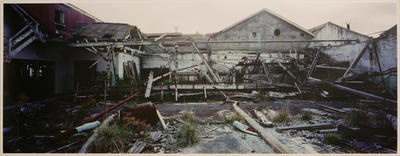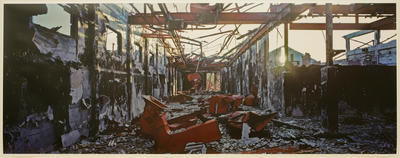Freezer Block from the 'Freezing Works, Patea: The Taranaki Scene'...
-
Jin Jiangbo
b.1972

Title
Freezer Block from the 'Freezing Works, Patea: The Taranaki Scene' series
Details
| Production Date | 2009 |
|---|---|
| Collection(s) | Acquired with support from the Lysaght-Watt Trust through the Govett-Brewster Foundation |
| Accession Number | 2011/2 |
| Edition | 1 of 8 |
| Media | Light jet archival print on Fuji paper scanned from large format (10 x 4 inch) colour transparency film. |
| Measurements | 1150 x 3000 mm |
About
The Taranaki Scene series was made in 2009 during Jin Jiangbo’s time as the Govett-Brewster International Artist in Residence. In the late 2000s, Jiangbo’s work manifested as photographic investigations into physical and economic landscapes. One series depicts deserted factories and buildings in Dongguan, China, showing the physical by-products of major changes in China due to economic retreat from the global financial crisis.
Upon his arrival in Aotearoa nearly ten years later, Jiangbo found parallels between the economic retreat in Dongguan and the dilapidated ruins of the freezing works in Pātea. The meat industry had dominated life in Pātea since 1887. Reaping the benefits of preferential access to British markets in the first half of the 20th century, the freezing works provided employment and income to most local households and businesses. This prosperity waned when Britain joined the European Economic Community (EEC) in 1973, and the works were closed in 1982. In 2008, the abandoned works were damaged by fire, the detritus remaining until a clean-up effort in late 2009.
Jiangbo’s series considers the freezing works a site of memory. Using a medium-format panoramic camera, Jiangbo went to ‘excavate and record’, unearthing Pātea’s unique economic and social histories lying just below the rubble of steel and asbestos. Although there is no explicit human presence in the photographs, they honour the workers associated with this site, acting as a permanent reminder of economic forces and their impact upon social fabrics. Though the area has since been cleared, the memory remains.
Hill tops and trees loom over the architecture, while undergrowth pushes through the concrete foundations. Despite the focus on human-made structures, nature quietly reclaims the space. The subject matter offers an update on the dawn of industry present in early colonial photography in Aotearoa, while the panoramic format aligns with the treatment of landscapes in Chinese scroll painting. Contrary to both genres, Jiangbo’s photographs are monumental in scale, making them immersive, heraldic and enabling a shared viewing experience.
— Maya Love, 2023


